

Summary by James R. Martin, Ph.D., CMA
Professor
Emertus, University of South Florida
Value and Valuation Main Page |
Gender and Feminist Main Page
This article is divided into 9 sections as follows:
1. Introduction
2. The vogue for valuation
3. Valuing the seemingly invaluable:
Human life
4. The organizational and temporal apparatus of valuing life:
Constructing the
economic value of man
5. Research context: Titanic, a tale of tragedy,
hubris and social class
6. Method and data sources
7. Valuing life: The
Titanic compensation claims
8. Discussion: Gendered lessons in the valuation
of life
9. Concluding comments
1. Introduction
The Titanic disaster provides a useful and very interesting setting for examining the valuation of human life. Developments in mortality statistics, life assurance, and compensation legislation in the 19th century in Britain and the U.S. had established a connection between the value of life and economic earning power. The economic model that emerged from this connection was inherently gender based because it ignored values beyond the world of compensation for work. Although the model worked for establishing the value of a man's life, it was of little use in 1912 for establishing values for the lives of women and children. The purpose of this article is to explore the role of gender in the practice of valuation and how the gender bias associated with the economic model subsequently resulted in the emergence of a variety of other valuation methods.
2. The vogue for valuation
Studies related to the issue of valuation are multidisciplinary in scope, and are a trending topic in the social sciences. The introduction of the journal Valuation Studies reflects the increased interest in this field of study. There are distinctions made between valuation and evaluation, economic value, cultural value, and intrinsic value, as well as quantitative and qualitative information in the valuation process. From a business perspective, accounting calculations are the basis for many valuation practices, and the concepts of value are numerous, but with the exception of slavery, the valuation of life has been neglected by accounting researchers.1 This study seeks to make a contribution to this unexplored area of valuation.
3. Valuing the seemingly invaluable: The value of human life
Money works well for establishing a value for market exchanges of goods and services, but market exchanges are generally considered morally inappropriate when considering the value of a human life. The economic model has been criticized on this basis by many valuation scholars who argue that the model should be more pluralistic in recognizing moral, ethical and other non-economic values. Closely related issues include the compensation for death or personal injury, and human organ donations. From these perspectives a number of valuation practices have been developed to value the seemingly invaluable.
4. The organization and temporal apparatus of valuing life: Constructing the economic value of man
The organizational and temporal apparatus of valuing life emerged in the 19th century when the development of life insurance and workers' compensation legislation began to equate the value of life with earning power. Mortality tables were used to calculate premium rates for life insurance based on life expectancy. Insurance began to be viewed as a moral duty of responsible husbands to provide for their dependents. There was also a growth in workman's compensation in the event of injury or death. Based on these concepts, the economic value of a man's life became measurable in monetary terms. Death became a major financial episode that ended a person's earning capability. All that was needed to determine the present value of a man's future earnings was an estimate of wages, the interest rate, and the applicable mortality table. Although this became the dominant model for the economic valuation of man, it was not applicable to woman. The gender bias of the work place had created a highly gender biased valuation of life.
5. Research context: Titanic, a tale of tragedy, hubris and social class
The Titanic had over 2,200 people on board with approximately 1,300 passengers and 900 crew members. The passengers included 325 travelling in 1st class, 277 in 2nd class and 706 in 3rd class. Most of the 1st class passengers were American, the majority of 2nd class passengers were English, and the steerage passengers were from a variety of countries with little but poverty in common.
The ship departed Belfast harbor on April 2nd. For four days and four nights the passengers and crew enjoyed an uneventful journey, but on the 14th of April the ship received warnings from other ships related to the presence of icebergs. However, the Titanic did not reduce its speed and the binoculars usually stored in the crows nest were missing. By the time the iceberg was sited it was too late to avoid a blow to the starboard side resulting in the flooding of five of the ship's watertight compartments. The ship's designer Thomas Andrews informed the Captain that they had about 2 hours before the Titanic would sink. The crew began to prepare the lifeboats and the ship's wireless operators began sending distress signals to ships across the Atlantic.
The ship had 16 wooden lifeboats and 4 collapsible with a total capacity of 1,178. The lack of lifeboats was compounded when many of the boats were launched with unfilled capacity. If the lifeboats had been completely filled, an additional 500 lives could have been saved reducing the number of deaths to around 1,000.2 There were stark contrasts in the treatment of the different classes of passenger. For example, 97% of the 1st class women survived compared to 46% of the 3rd class women, and 100% of the 1st class children survived compared to 34% of the 3rd class children.
Two inquiries into the cause of the disaster found that the Captain made an unwise decision not to slow the ship, but they did not find him negligent.
6. Method and data sources
The White Star Line lodged a petition after October 12 with the Southern District Court of New York to limit its liability for the loss of life and property during the sinking of the Titanic. Although claims for compensation amounted to over $16 million, the settlement amounted to only $664,000. In July 1916 the final judgment in the case found the White Star Line was not liable for any loss of life or property.
The main data sources for the paper are as follows: The claims reviewed included four different categories: Schedule A claims for loss of life, Schedule B claims for loss of property, Schedule C claims for loss of life and property, and Schedule D claims for personal injuries and property. This includes 651 total claims for compensation, and 381 of these relate to loss of life. There are no records of what was paid to each claimant, only the total value of the settlement.
7. Valuing life: The Titanic compensation claims
The total number of claims in each category and the amount of these claims is summarized in Table 1 below. In total there were 651 claims for $16,604,718. However, the focus of this study is on loss of life claims in Schedules A and C.
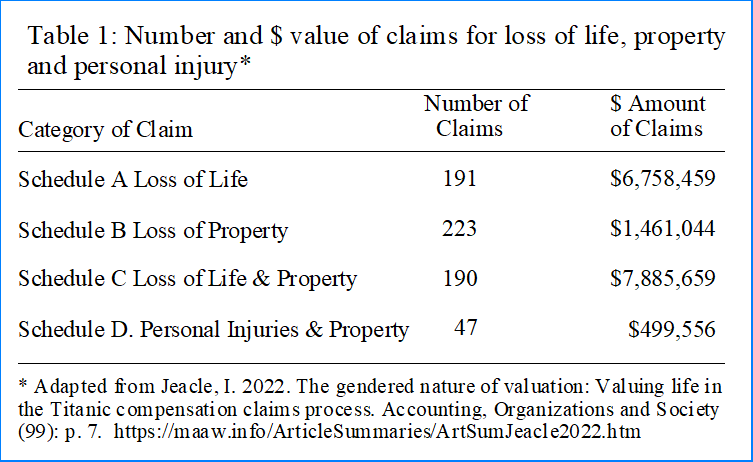
Most of the claims for loss of life were made by widows, and the amount of each claim was invariably made for lost of earnings capacity based on the annual income of the deceased husbands.3 This resulted in large differences in the amounts claimed by each widow. For examples see Table 2 below. I added Alfonso Meo and Henry Harris to the table to include the lowest and highest claim amounts although their annual incomes were not given. Meo was an Italian musician who probably had little income, and Henry Harris was a wealthy theater owner and Broadway producer.
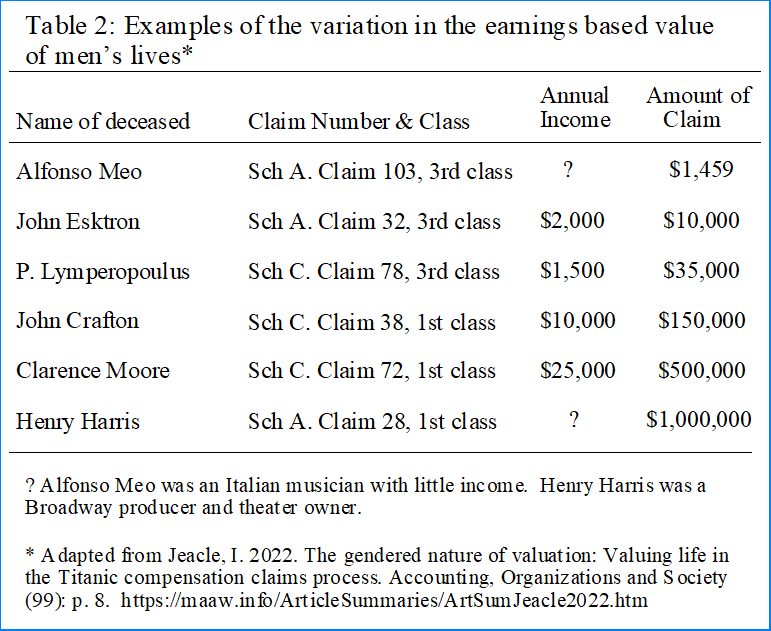
There was an interesting group claim made by the Belgian Council for the relatives of the Belgian citizens lost in the disaster. The lives of ten men and one woman were all valued at the exact same amount of $8,500. Loss of life claims were not all made by widows. Some of the claims also involved parents, siblings, and grandparents as dependents. Table 3 illustrates the wide variations in loss of life claims made by the three classes of passenger.
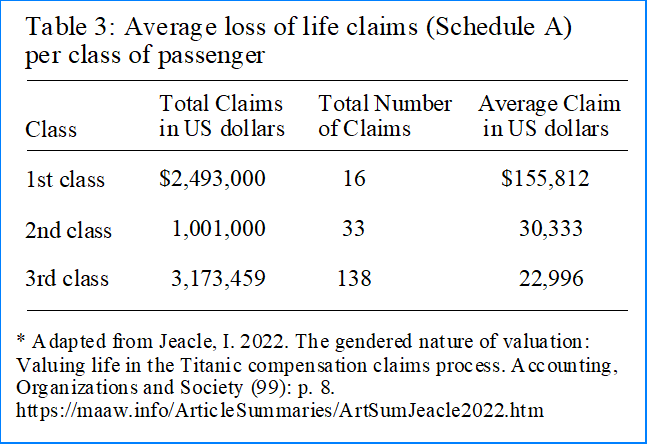
The claimants did receive some aid from other sources. In the U.S. the American Red Cross provided aid to 326 claimants, and the crew of the Titanic received aid from the British based Titanic Relief Fund calculated on the basis of the annual earnings of the deceased.
Although most of the lives lost were men, a small number of claims were made for the death of women passengers, and there is a silence on how their lives were valued. Since most women's lives could not be valued using earnings capacity, the valuation of their lives became completely arbitrary. Some examples are provided in Table 4.
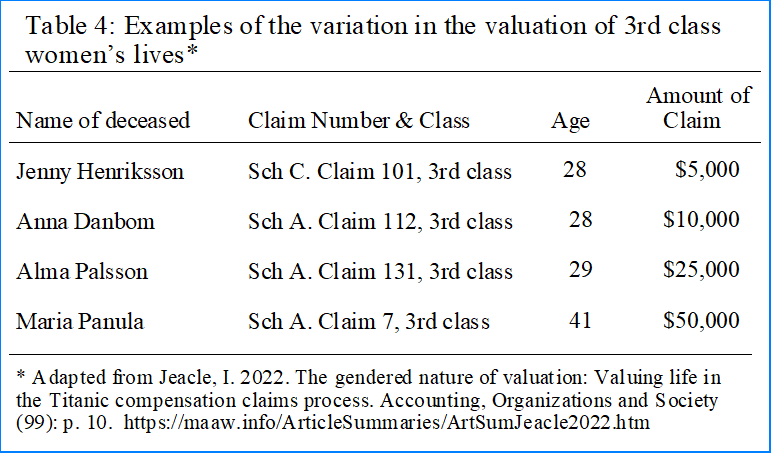
Children also fall into the group of lives lost that cannot be valued using earnings capacity, and the claims for their lives were also quite different. Table 5 provides some examples. Note that passenger class had no bearing on the differences since all the children lost were from the 3rd class. There is an inconsistency in the valuation practices for women and children and it is present across the class categories.
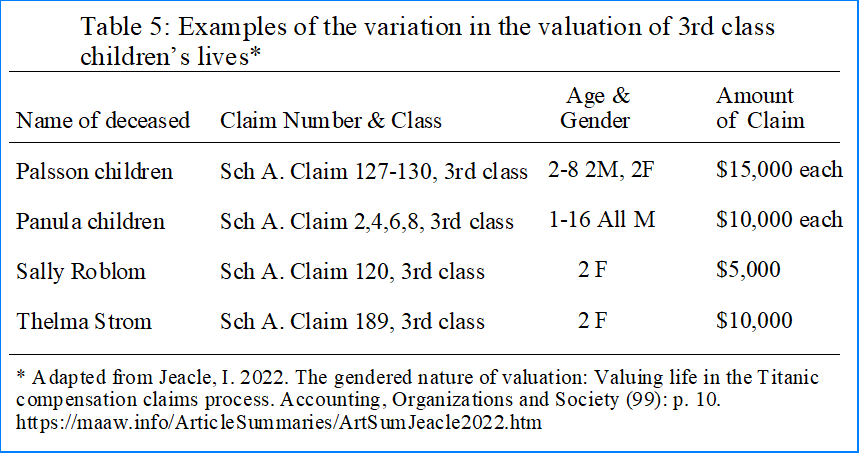
8. Discussion: Gendered lessons in the valuation of life
The Titanic compensation claims are an example of where the value of individual lives are measured on a single scale using the common metric of money. Money is used to create equivalences between incomparable situations that produces large conflicting values to make the seemingly incommensurable commensurable. Social class influenced the values in the compensation claims and also in the values attributed to the corpses recovered after the sinking. Since life insurance payouts required a corpse, the decision was made to bring 1st and 2nd class passengers home and bury 3rd class passengers at sea.
Valuing a life on the basis of earnings capacity captures a market value, but it ignores all other measures of worth. Clearly there were other measures attributed to women and children, but we do not know precisely what they were. However, it is also clear that the valuations were made and produced a wide range of values that suggests that different measures of worth, or methods or concepts of evaluation were used such as emotional, sentimental, affection, companionship, moral or personal values. The Titanic was a "valuation event" that created a rupture in the existing method of valuing life based on earnings. The economic earnings model was a gender biased model constructed around men and the world of paid work. A contribution of this paper is to recognize the gendered nature of the process, institutions and calculations that produce value judgments about life.
9. Concluding comments
The Titanic is a gripping tale of wealth and poverty facing a similar fate and provides incite into the process and practice of valuing human life. The data set, although limited by the lack of information about the actual amounts of compensation paid, shows that there was a significant difference in the method of valuing the lives of men versus women and children. It also shows that to understand the practice of valuation it is vital to recognize the gendered nature of the valuation process to understand how we value other things such as work, leisure, and personal freedom.
____________________________________
1 A non-inclusive list of concepts of value found in accounting literature include: Abandonment value, added value, appraisal value, book value, contingent value, disposal value, economic value, entity value, equity value, fair value, goodwill value, human resource value, intangible value, joint value, market value, present value, replacement value, slave value, stockholder value, and strategic value.
2 Most of the passengers and crew in the water probably died within about 15 minutes since the temperature of the water was reported to be around 28 degrees.
3 A table in Wikipedia shows the lives lost included 1,352 men, 109 women, and 53 children.
Related summaries:
Dummer, W., M. Masters and D. Swenson. 2015. Delivering customer value through value analysis. Cost Management (March/April): 17-24. (Summary).
Martin, J. R. Not dated. What is a business valuation? Management And Accounting Web. Business Valuation